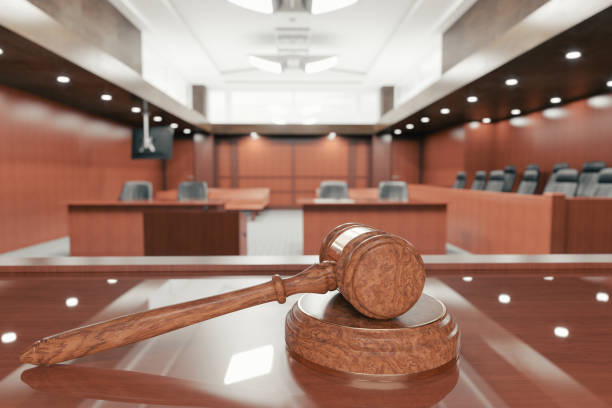Arraignment refers to the court hearing where a defendant is formally charged with a criminal law offence and is asked to enter a plea of guilty or not guilty.
The arraignment occurs in local or district courts and is one of the early stages of the criminal trial process. During the arraignment, the judge or magistrate will read out the charges against the accused person.
They will also explain the possible penalties if the defendant is found guilty. The defendant will then be asked to enter a plea of guilty or not guilty.
If the defendant pleads guilty, the court will proceed to the sentencing stage, where the judge or magistrate will determine the appropriate penalty. If the accused pleads not guilty, the case will proceed to trial with the presence of a jury panel.
It’s worth noting that arraignment procedures may vary slightly between different Australian states and territories. However, the basic purpose of arraignment remains the same which is to formally charge the defendant and establish their plea. This is carried out before moving forward with the criminal trial process.
What Does the Criminal Procedure Act 1986 Say?
Section 152 of the Criminal Procedure Act 1986 (NSW) deals with an arraignment on a charge of a previous conviction in NSW. Under Section 152, the prosecutor may give notice of their intention to rely on the previous conviction to increase the penalty for the new offence. This is true if a person is charged with an offence and has been previously convicted of an offence.
This notice is referred to as a “recidivist declaration”. The notice must be given in writing to the defendant or their legal representative. At the arraignment, the judge or the judge’s associate will read the charges against the defendant and inform them that they are being charged as a repeat offender. The defendant will then be asked to enter a plea of guilty or not guilty.
What Happens During an Arraignment?
The following are the typical events that occur during an arraignment. Usually, the defendant is:
1. Informed of the charges against them: The judge or prosecutor will read out the charges against the defendant. This may include information about the nature of the offence, the penalties, and other important details.
2. Asked to enter a plea: The judge will ask the person accused to enter a guilty or not guilty plea after the charges have been read. If the defendant pleads guilty, the case will proceed to the sentencing of the defendant. If the defendant pleads not guilty, the case will move to the trial phase.
3. Eligible for bail: In some cases, the judge may address bail during the arraignment. If the defendant is eligible for bail, the judge will determine the amount and conditions of bail.
4. Advised of their rights: The judge will advise the defendant of their legal rights, such as the right to:
- An attorney
- Remain silent (or the accused refuses to answer the police); and/or
- A fair trial.
5. Subject for next steps of the case: If the defendant enters a plea of not guilty, the judge will schedule an arraignment date and discuss other important matters, such as discovery, motions, and pretrial conferences.

Where Does an Arraignment Take Place?
In Australia, arraignments usually take place in a district court. The specific court will depend on the jurisdiction and the nature of the offence. In most cases, arraignments for summary offences will take place in a local or magistrates’ court. More serious offences are heard in higher courts, such as the district or supreme courts.
The defendant will typically be required to attend court in person for the arraignment, although in some cases, they may be able to attend via video conference. This is if they are in custody or if they are unable to attend court in person due to a valid reason.
It’s worth noting that the specific procedures and rules for arraignment may vary between different states and territories in Australia. Defendants should seek legal advice to ensure they understand the requirements and procedures in their jurisdiction.
Arraignment Example
Bailey Smith is charged with stealing a car. She is brought before a magistrate in a local court for her arraignment. The magistrate reads out the charge against her and informs her right to legal representation. The magistrate asks Bailey how she pleads to the charge of stealing a car. Bailey responds by saying “not guilty.”
The magistrate then explains to Bailey that a trial will be scheduled, and she will have the opportunity to present her case and challenge the evidence presented by the prosecution. The magistrate also explains that Bailey has the right to apply for bail while awaiting trial. Moreover, if Bailey is granted bail, she will be required to attend all court hearings.
Bailey is then given a date for her to stand trial and is released on bail. She is required to attend court on the scheduled trial date. This is where the prosecution will present their evidence and Bailey will have the opportunity to defend herself against the charge of stealing a car. This is just one example of what an arraignment might look like. Additionally, the specific procedures and rules may vary depending on the jurisdiction and the nature of the offence.
Categories of Criminal Offences
Defendants should also be knowledgeable about the category of criminal offence they committed should they plead guilty during an arraignment. Here are the 4 categories of criminal offences in Australia.
1. Summary Offences
Summary offences are minor criminal offences that are generally heard in a local or magistrates’ court. These offences are considered less serious than indictable offences, which are heard in higher courts such as district or supreme courts. Examples of summary offences may include:
- Traffic offences, such as speeding or running a red light
- Public order offences, such as disorderly conduct or offensive language
- Minor property offences, such as shoplifting or vandalism
- Minor drug offences, such as possession of a small quantity of drugs
2. Table 2 Offences
Table 2 offences refer to certain types of indictable offences that are considered less serious than other indictable offences. These offences are listed in Schedule 2 of the Criminal Procedure Act, which sets out the procedures for indictable offences in NSW. Table 2 offences include a range of non-violent offences such as:
- Burglary
- Stealing
- Possession or supply of prohibited drugs
- Dangerous driving
3. Table 1 Offences
Table 1 offences refer to the most serious types of indictable offences. These offences are listed in Schedule 1 of the Criminal Procedure Act, which sets out the procedures for dealing with indictable offences in NSW. Table 1 offences include a range of violent offences, such as:
- Murder
- Manslaughter
- Sexual assault
- Armed robbery
4. Strictly Indictable Offence
Strictly indictable offences must be heard in a higher court, such as the District or Supreme Court, rather than a local or magistrates’ court. These offences are considered more serious than other indictable offences, and the penalties for conviction are often more severe. Examples of strictly indictable offences may include:
- Murder and other serious violent offences
- Drug trafficking and other serious drug offences
- Serious sexual offences, such as rape and sexual assault
- Fraud and other serious white-collar crimes

Importance of Hiring a Legal Practitioner
Arraignment procedures should be taken seriously since criminal offences have various penalties. That’s why defendants should seek legal advice from JB Solicitors’ criminal lawyers.
Our team is experienced in defending clients who want to plead not guilty in court. We can also help defendants who want a lighter penalty if they want to plead guilty to a criminal offence.
Message an experienced criminal lawyer today.
